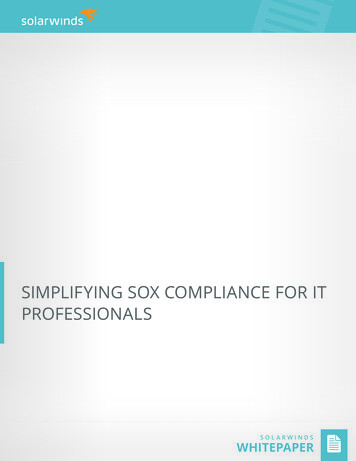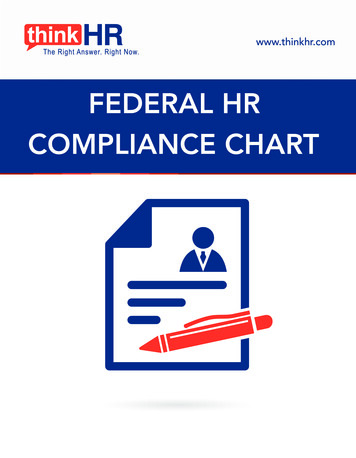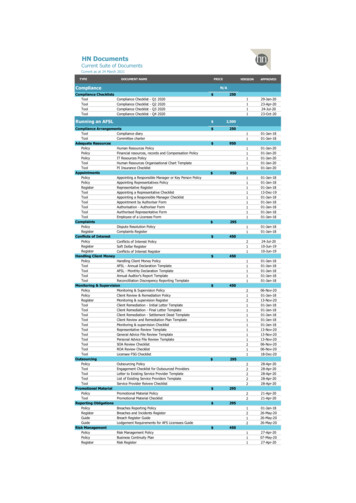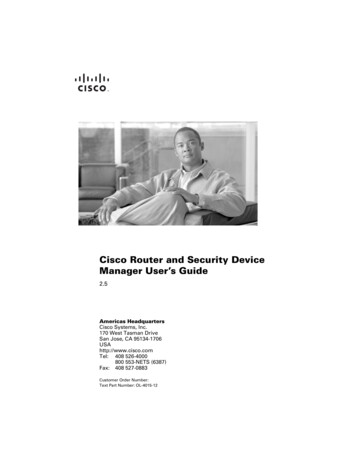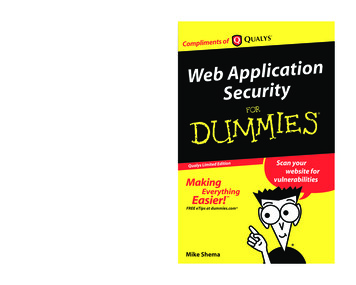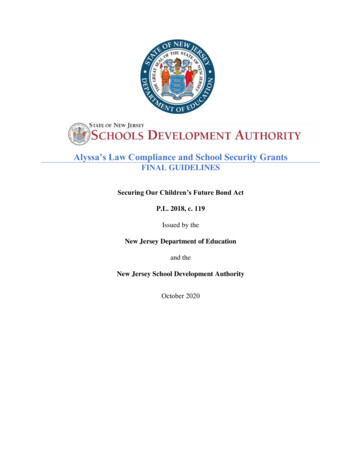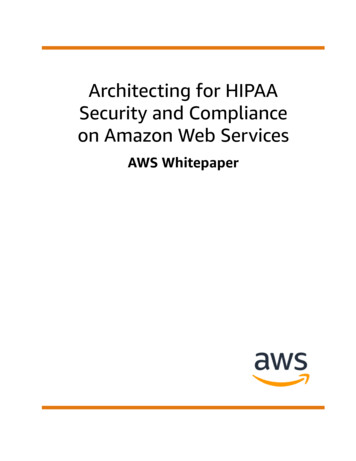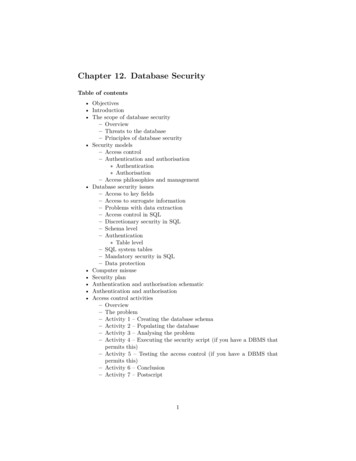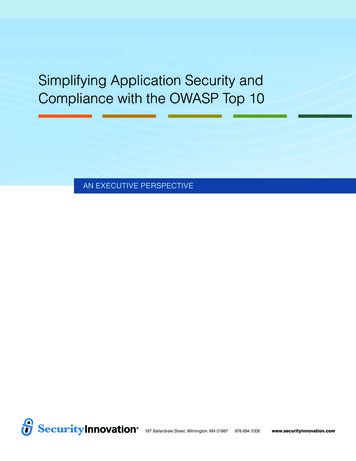
Transcription
Simplifying Application Security andCompliance with the OWASP Top 10An Executive Perspective187 Ballardvale Street, Wilmington, MA 01887978.694.1008www.securityinnovation.com
ExECuTivE PErSPECTivE2Simplifying Application Security and Compliance with the OWASP Top 10introductionFrom a management perspective, application security is a difficult topic. Multiple partieswithin an organization are involved, as well as a varying collection of technologies intendedto provide better security. As new threats and regulations create moving targets, it hasbecome increasingly difficult to connect proposed remedies with specific results.However, many leading enterprises have found an approach that cuts through much ofthis complexity. They are using the OWASP Top 10 list of critical security risks to focustheir application security and compliance initiatives.in this management briefing we willThe concept:answer the following questions:build processes to prevent the ten most Why is application securityserious web-based attacks, and thoseimportant? What is the oWasp top 10? how can the oWasp top 10 be usedto transform application security?processes will help you reduce manytypes of security risks, and at the sametime cut development costs. how can the oWasp top 10 helpwith compliance? is this approach cost-effective? What tools are available to ensurebest practices around the oWasptop 10?www.securityinnovation.com
ExECuTivE PErSPECTivE3Simplifying Application Security and Compliance with the OWASP Top 10Why is Application Security important?Everyone acknowledges that iT security is important. Certainly the costs of failure are high: a recent surveyfound an average cost of 7.2 million per data breach event (or 214 per compromised customer record). Thesame survey found that 88% of the organizations surveyed had at least one major data breach in 2010.1The problem is that, although most enterprises have invested in network and PC security, many have neglectedto build adequate safeguards into their software applications.Application security is rapidly being recognized as a top priority. Gartner has stated that: “Over 70% of securityvulnerabilities exist at the application layer, not the network layer,” and otherresearchers have estimated this figure at 90%.2 State laws requiring theprompt disclosure of data breach problems are causing companies to lookmore closely at applications that process customer information. And indus-Organizations incorporatingthe OWASP Top 10into security programs:try standards bodies and government agencies are increasingly emphasizing application security, including the Payment Card industry SecurityStandards Council and the u.S. National institute of Standardsand Technology (NiST).3A.G. EdwardsBritish TelecomCitibankHPIBM Global ServicesWhat is the OWASP Top 10?But what is the best way to address an issue that that affects everysoftware developer and virtually every piece of software within anorganization? That is where the OWASP Top 10 list has been helpful.Since 2003, the Open Web Application Security Project (OWASP) haspublished a list of the ten most critical web application security risks.4Michigan State UniversityPrice Waterhouse CoopersREISamsung SDS (Korea)SprintSymantecThe HartfordThis list represents a consensus among many of the world’s leadinginformation security experts about the greatest risks, based on boththe frequency of the attacks and the magnitude of their impact onbusinesses.The objective of the OWASP Top 10 project is not only to raise awareness about ten specific risks, but also toeducate business managers and technical personnel on how to assess and protect against a wide range ofapplication vulnerabilities.This use of the OWASP Top 10 has been embraced by many of the world’s leading iT organizations, includingthose listed on this page.www.securityinnovation.com
E x ec u t i v e P e r spect i v e4Simplifying Application Security and Compliance with the OWASP Top 10The OWASP Top 10 has also become a key reference list for many standards bodies, including the PCISecurity Standards Council, NIST and the FTC.The bottom line:Organizations that put in place the people, tools andprocesses to protect against the OWASP Top 10 riskswill develop first-class application security programscapable of handling a wide range of web-based threats.Understanding the Security RisksThe OWASP Top 10 risks are listed in the Appendix. Here we will give a quick overview of two of them.The first risk on the list is “Injection.” This means tricking an application into including unintended commandsin the data sent to a database or another “interpreter.” For example, a web form might ask for an accountnumber. An attacker, instead of entering a legitimate account number, might enter something like this:‘ OR 1 1 -If the application sends these characters to a database, the database will collect a group of account numbersand send those back to the attacker. The consequences can be extremely serious: the attacker can get fullaccess to hundreds of customer accounts.Similar consequences can result from the eighth entry on the list, “Failure to Restrict URL Access.” Anattacker on an online shopping web site might notice that part of the address of his account page is/user/getAccounts, and from that guess that there is another web page /manager/getAccounts usedby administrators to manage user accounts. Unless the /manager/getAccounts page is properly protected,the attacker can use it to steal confidential customer data.www.securityinnovation.com
E x ec u t i v e P e r spect i v e5Simplifying Application Security and Compliance with the OWASP Top 10How Can the OWASP Top 10 Be Used to TransformApplication Security?The OWASP organization suggests that the OWASP Top 10 list can be used to “establish a strong foundation oftraining, standards and tools that makes secure coding possible.”5Enterprises who have implemented a successful application security program integrate the OWASP Top 10 intoeach stage of their software development lifecycle (SDLC) to design, develop and test new software applications.The diagram below demonstrates how this can be done.PhaseOWASP Top 10 UseRequirements and AnalysisThreat Modeling: use Top 10 as guide to potential attacks. Determinecountermeasures.Architecture and DesignSecurity Design Guidelines: Adopt design guidelines that will hardenapplications against Top 10.DevelopmentAdopt coding standards to counter Top 10. Search for Top 10 code reviews.TestingDevelop test plans for Top 10. Test for Top 10 with static analysis tools.Scan for Top 10 with web scanning tools.DeploymentCheck for configuration and physical deployment errors related to Top 10.MaintenanceConduct ongoing scanning for Top 10.1. Requirements and analysisIn the Requirements and Analysis phase, analysts consider the requirements and goals of the application,as well as possible problems and constraints. Part of this process involves threat modeling, which identifiesthreats and vulnerabilities relevant to the application.The OWASP Top 10 can be used as guides to potential attacks. A thorough examination of which of those 10risks could affect the software will suggest ways the application design can be shaped to achieve securityobjectives, and where resources could be applied to develop countermeasures.www.securityinnovation.com
E x ec u t i v e P e r spect i v e6Simplifying Application Security and Compliance with the OWASP Top 102. Architecture and designIn the Architecture and Design phase, specific design guidelines can be adopted that are proven solutionsto the Top 10 risks. For example, if the application is potentially susceptible to injection attacks specific guidelines can be adopted, such as always requiring centralized input validation that differentiates data (accountnumbers) from code (commands to the database).3. DevelopmentIn the Development phase, specific coding standards that have been proven to defend against the Top 10risks can be adopted. To use our injection risk example again, developers could be required to have theirsoftware encode user-supplied input; that is, to tell the database “these characters come from a user screen,so they are definitely data and should never be executed as commands.”To address some of the “Failure to Restrict URL Access” issues, coding standards might require that everyweb page be protected by role-based permissions. For example, special logon screens for managers couldbe added to prevent attackers (and non-management employees) from accessing management screens.Code reviews are another activity that typically occurs during the Development phase. Most developersreview code only to make sure that it has the features and functions described in the specification. Butdevelopers trained to look also for vulnerabilities in the code related to the OWASP Top 10 will find many typesof security issues.4. TestingWhen the quality assurance group builds the test plan, it can ensure that specific tests are run to simulateattacks related to the Top 10 risks.Static analysis tools which read through software code, can be programmed to look for clues in the codethat the application may be vulnerable to Top 10 risks. Web scanning tools can be programmed to simulateattacks based on Top 10 vulnerabilities. For example, they could be set up to attempt injection attacks onall customer input screens.5. DeploymentComputer systems and software that are not configured with security in mind can open up systems toattacks. That is why the OWASP Top 10 can be very helpful in the Deployment phase of the software lifecycle. For example, many problems can be prevented by ensuring that unnecessary utility software is shutoff on servers, and that auditing and logging services are always turned on.www.securityinnovation.com
ExECuTivE PErSPECTivE7Simplifying Application Security and Compliance with the OWASP Top 106. maintenanceFinally, in the maintenance phase of the life cycle, a focus on the OWASP Top 10 will ensure that organizationsconduct ongoing reviews and code scanning, to find out if changes to the application over time might havecreated any new vulnerabilities.in short, integrating the OWASP Top 10 into every phase of the software development life cycle forcesdevelopment organizations to adopt security best practices and learn how to use software testing tools.And these best practices and testing tools will help eliminate mitigate the risks, not just of the OWASP Top 10,but for many types of security risks.S eCURe SO FTWARe DeVelOPmenTDeFine DeSiGn bUilD RiSK mAnAGemenTTeST bUilDTeST how Can the OWASP Top 10 help with Compliance?For some enterprises, addressing the OWASP Top 10 risks is mandatory for industry and regulatory compliance.For others it is optional, but provides an excellent way of demonstrating a high level of effort in addressingcompliance issues.Pci DssThe PCi DSS rules specifically require addressing the Top 10. PCi DSS requirement 6.5 states: “Developapplications based on secure coding guidelines. Prevent common coding vulnerabilities in softwaredevelopment processes.as industry best practices for vulnerability management are updated (forexample, the OWASP Guide, SANS CWE Top 25, CErT Secure Coding, etc.), the current best practicesmust be used for these requirements.”in fact, the PCi DSS requirements 6.1 to 6.9 map directly to 8 of the OWASP Top 10, as shown in the diagramshown on the next page.www.securityinnovation.com
ExECuTivE PErSPECTivE8Simplifying Application Security and Compliance with the OWASP Top 10PCi DSS Requirements6.5.1Injection flaws, particularly SQL injection.Also consider OS Command Injection,LDAP and XPath injection flaws as wellas other injection flaws.Top 10 most Critical Web Application Security RisksA1InjectionA2Cross-site Scripting (XSS)A3Broken Authentication and Session ManagementA4Insecure Direct Object References6.5.5 Improper error handlingA5Cross-site Request Forgery (CSRF)6.5.6 All “High” vulnerabilities identified in thevulnerability identification process(as defined in PCI DSS Requirement 6.2).*A6Security Misconfiguration (NEW)A7Failure to Restrict URL AccessA8Unvalidated Redirects and Forwards (NEW)A9Insecure Cryptographic Storage6.5.2 Buffer overflow6.5.3 Insecure cryptographic storage6.5.4 Insecure communicationsThese apply to web applications andapplication interfaces (internal or external)6.5.7 Cross-site scripting (XSS)6.5.8 Improper Access Control (such as insecuredirect object references, failure to restrictURL access, and directory traversal)A10Insufficient Transport Layer Protection6.5.9 Cross-site request forgery (CSRF)* This requirement is considered a best practice until June 30, 2012, after which it becomes a requirement.other standardsMost standards and regulations are not as explicit as PCi DSS in addressing the OWASP Top 10. However,several others do call for following best practices in the area of application security.For example, the Department of Defense and Defense information Systems Agency (DiSA) recently publishedthe 114-page Application Security and Development Security Technical implementation Guide with detailedrecommendations for creating a secure SDLC.6 HiPAA requires that covered organizations perform risksanalysis and risks assessments, and in some cases ensure that proper controls are in place for web applications. And a new iSO standard is under development: iSO 27034: Guidelines for Application Security.Essentially, auditors are likely to view the failure to address the OWASP Top 10 as a sign that the organizationis falling short of compliance with many standards, while integrating the Top 10 into the software developmentlife cycle demonstrates that many best practices have been implemented as part of the security process.www.securityinnovation.com
E x ec u t i v e P e r spect i v e9Simplifying Application Security and Compliance with the OWASP Top 10Is this Approach Cost-effective?At this point in our discussion some readers might say: “Why do we need such a new set of programs? Don’tsoftware developers already know how to implement application security?” But in fact, very few have beeneducated on secure coding practices. And even when they have been, emerging threats require refreshercourses every year or two based on how attach methodologies continue to change. So educational programsbuilt around the OWASP Top 10 provide essential education that most developers might not seek to acquireon their own.Other readers might ask “Wouldn’t it be cheaper to buy a few software testing tools and let them detectvulnerabilities in applications?” But software testing tools are almost useless unless developers learn how touse them and know where to point them. In fact, they can be worse than useless, because if not usedproperly they can generate large numbers of “false positives” that cause resources to be wasted huntingdown non-existent bugs.A third common misconception is that programs designed to improve application security can be focusedonly on software coding. Many security and compliance requirements are missed during the requirementsand design phases of the life cycle, and many vulnerabilities are created during the deployment andmaintenance phases.JustificationDo application security programs have a return on investment?Part of the answer obviously relates to preventing costly security breaches, and the emergence of advancedthreats. As mentioned earlier, a recent survey found an average cost of 7.2 million per data breach, or 214 per compromised customer record, to cover expenses like customer notification, regulatory fines, andcleaning up the damage to internal systems. More than ever, enterprises must take into account the potentialfor serious damage to reputation and to customer relationships.A second area is compliance. Compliance activities can be costly and time-consuming, and can take management attention away from more strategic projects. A well-documented application security program built aroundthe OWASP Top 10 can streamline compliance processes and free up resources for more productive tasks.Finally, a program that identifies application security issues early can save a tremendous amount of moneyover trying to identify and fix requirements in the later phases of the software development life cycle. Studieshave calculated that preventing defects in the design phase requires one-tenth the effort of catching andfixing those defects at the system test phase. Gartner estimates that removing 50 percent of software vulnerabilities prior to applications being put into production can reduce configuration management and incidentresponse costs by 75 percent.7www.securityinnovation.com
E x ec u t i v e P e r spect i v e10Simplifying Application Security and Compliance with the OWASP Top 10What Tools are available to ensure best practices around the OWASP Top 10?As discussed in this paper, a program built around the OWASP Top 10 can provide a powerful foundation toeffectively focus and organize an application security program. But implementing such a program successfully the first time requires an accumulation of knowledge and experience.Security Innovation provides products, training and consulting services to help organizations build and deploysecure software, but also in implementing a best practices model based on the OWASP top 10.These offerings include: Consulting services to assess application risk across the entire application portfolio, how to implement asecure software development life cycle, including SDLC assessment and optimization, code reviews, threatmodeling and penetration testing. TeamProfessor eLearning, including courses like “OWASP Top Ten: Threats and Mitigations,” “How to Testfor the OWASP Top Ten,” and many courses on secure coding practices for ASP.Net, Java, C , Windowsand other development environments. TeamMentor, the industry’s largest and only secure software development knowledgebase repository thatprovides intelligence at every stage of the development lifecycle, the perfect “In-Practice” reference guidefor novice and advanced developers and designers, architects, project managers and security teams.To Learn More:For more information, please visit Security Innovation’s web site athttp://www.securityinnovation.com.To evaluate the company’s eLearning products, please contact us at 1.877.694.1008 x1 or ation.com
E x ec u t i v e P e r spect i v e11Simplifying Application Security and Compliance with the OWASP Top 10AppendixOWASP Top 10 Application Security Risks —2010A1InjectionInjection flaws, such as SQL, OS, and LDAP injection, occur when untrusted data is sent to aninterpreter as part of a command or query. The attacker’s hostile data can trick the interpreterinto executing unintended commands or accessing unauthorized data.A2Cross-siteScripting (XSS)XSS flaws occur whenever an application takes untrusted data and sends it to a web browser withoutproper validation and escaping. XSS allows attackers to execute scripts in the victim’s browser whichcan hijack user sessions, deface web sites, or redirect the user to malicious sites.A3BrokenAuthenticationand SessionManagementApplication functions related to authentication and session management are often not implementedcorrectly, allowing attackers to compromise passwords, keys, session tokens, or exploit otherimplementation flaws to assume other users’ identities.A4Insecure DirectObject ReferencesA direct object reference occurs when a developer exposes a reference to an internal implementationobject, such as a file, directory, or database key. Without an access control check or other protection,attackers can manipulate these references to access unauthorized data.A5Cross-siteRequest Forgery(CSRF)A CSRF attack forces a logged-on victim’s browser to send a forged HTTP request, including thevictim’s session cookie and any other automatically included authentication information, to a vulnerableweb application. This allows the attacker to force the victim’s browser to generate requests thevulnerable application thinks are legitimate requests from the victim.A6SecurityMisconfigurationGood security requires having a secure configuration defined and deployed for the application,frameworks, application server, web server, database server, and platform. All these settingsshould be defined, implemented, and maintained as many are not shipped with secure defaults.This includes keeping all software up to date, including all code libraries used by the application.A7InsecureCryptographicStorageMany web applications do not properly protect sensitive data, such as credit cards, SSNs, andauthentication credentials, with appropriate encryption or hashing. Attackers may steal or modifysuch weakly protected data to conduct identity theft, credit card fraud, or other crimes.A8Failure toRestrict URLAccessMany web applications check URL access rights before rendering protected links and buttons.However, applications need to perform similar access control checks each time these pages areaccessed, or attackers will be able to forge URLs to access these hidden pages anyway.A9InsufficientTransport LayerProtectionApplications frequently fail to authenticate, encrypt, and protect the confidentiality and integrityof sensitive network traffic. When they do, they sometimes support weak algorithms, use expiredor invalid certificates, or do not use them correctlyA10UnvalidatedRedirects andForwardsWeb applications frequently redirect and forward users to other pages and websites, and useuntrusted data to determine the destination pages. Without proper validation, attackers canredirect victims to phishing or malware sites, or use forwards to access unauthorized pages.www.securityinnovation.com
E x ec u t i v e P e r spect i v e12Simplifying Application Security and Compliance with the OWASP Top 10NotesPonemon Institute, 2010 Annual Study: U.S. Cost of a Data Breach, March 2011. Press release: http://www.ponemon.org/blog/post/cost-of-a-data-1 breach-climbs-higher. Full study: http://bit.ly/hlgCne.23 Estimate from Gartner, quoted in Computerworld, February 25, 2005: ,99981,00.html. See https://www.pcisecuritystandards.org/documents/pci dss v2.pdf; https://www.pcisecuritystandards.org/pdfs/summary of changes highlights.pdf;NIST Special Publication 800-53A Rev 1:Guide for Assessing the Security Controls in Federal Information Systems and stpubs/800-53A-rev1/sp800-53A-rev1-final.pdf.4 OWASP Top 10 project home: https://www.owasp.org/index.php/Category:OWASP Top Ten Project. OWASP Top 10 for 2010 release ASP%20Top%2010%20-%202010.pdf. OWASP Top 10 for 2010 slide s/OWASP Top 10 - 2010%20Presentation.pptx.5 OWASP Top 10 for 2010 release document: %2010%20-%202010.pdf.6 Department of Defense/DISA Application Security and Development Security Technical Implementation Guide, Vol. 3, Release 2:http://iase.disa.mil/stigs/downloads/zip/u application security and development stig v3r2 20101029.zip.7 The cost of finding defects at different stages of the development life cycle were estimated by B. W. Boehm and P. N.Papaccio in: Understandingand Controlling Software Costs, IEEE Transactions on Software Engineering, Vol. 14, No. 10, p.1462-1477, October 1988, and by IDC andIBM Systems Sciences Institute, quoted in Microsoft Security Development Lifecycle: The Gartner estimate is from: http://www.gartner.com/press releases/asset 106327 11.html. 2011 Security Innovation. All rights reserved.www.securityinnovation.com
Testing Develop test plans for Top 10. Test for Top 10 with static analysis tools. Scan for Top 10 with web scanning tools. Deployment Check for configuration and physical deployment errors related to Top 10. . example, the OWASP Guide, SANS CWE Top 25, CErT Secure Coding, etc.), the current best practices .
